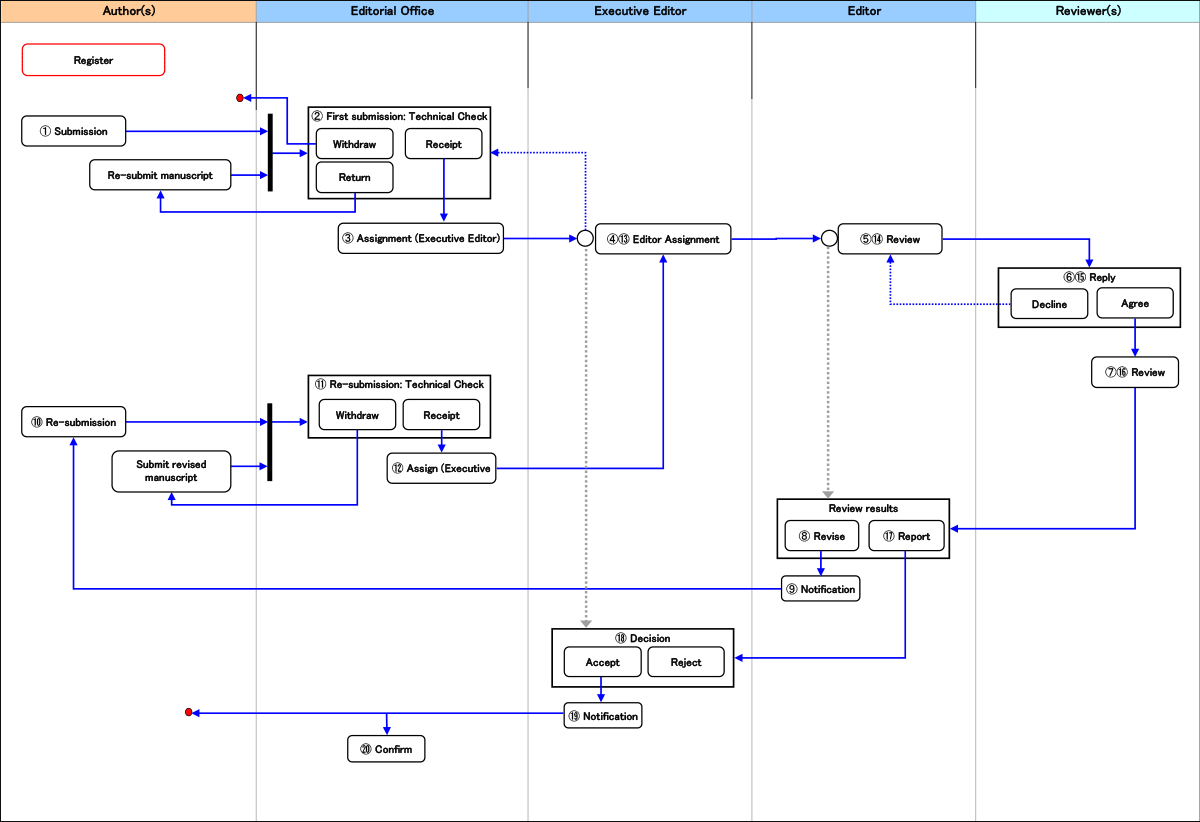For Reviewers
Thank you for your continued cooperation with the editing of Nankyoku Shiryô [Antarctic Record]. Reviewers are asked to read the following summary of the review process and manuscript review guidelines.
Online manuscript review system
Nankyoku Shiryô [Antarctic Record] adopts the “Editorial Manager” on-line manuscript submission and review system. Review requests are sent by e-mail from this system. Manuscripts can be reviewed at any time via online when you log onto to the system.
Flow of manuscript review process
The Editorial Office monitors the progress of manuscript review and will help the editor / reviewer’s operation by using “proxy” function.
Purpose of Review
In addition to improving the content of the manuscripts that are submitted, the review process serves the function of selecting information that should be shared among researchers and technicians. Effective review promotes high quality scientific communication and, thereby, contributes to robust and rigorous polar science research. The following guidelines are provided as a reference to reviewers. We thank the reviewers in advance for their cooperation.
Review requests
Once you have agreed to review a manuscript, please complete the review and submit the review results using Editorial Manager within the period specified below.
> Review period: within 2 weeks (also 2 weeks in the case of re-submission)
Please immediately decline the review if any of the following apply:
1. If you receive a manuscript that is outside your field of expertise and you determine that review is not possible,
2. If you receive a manuscript by an author(s) with whom you have any conflict of interest, or
3. If you are unable to complete the review in the specified period due to extended business travel or other commitments.
There will be two reviewers for each research paper, research note, and review, and one reviewer for each report.
Manuscript review guidelines
The goal of Nankyoku Shiryô [Antarctic Record] is rapid publication of observations by the Japanese Antarctic Research Expedition, findings from research using data and samples from Antarctic research expeditions, and summaries of research findings related to Antarctic research projects. Scientific research findings and official reports relating to the polar regions in general, including the Arctic, are also published.
The following is a list of points to be evaluated. Please keep them in mind when conducting your review.
| 1. Suitability | Does the manuscript fit the scope of Nankyoku Shiryô [Antarctic Record]? |
|---|---|
| 2. Logic | Is the manuscript presented in a coherent, logical manner? |
| 3. Appropriateness of references | Does the paper cite major references relevant to the research objective and topic? |
| 4. Originality (for research papers only) |
When placed in the context of previous research, do the results lead to new conclusions and insights? |
| 5. Others |
Review results
1. Evaluation criteria for the five decision types are as follows:
“Accept“…No issues identified.
“Minor revision”…Manuscript can be accepted after revision of wording and other minor issues.
“Major revision without re-review”… Manuscript can be accepted without re-review after issues identified by the reviewers are addressed.
“Major revision with re-review”… Manuscript must undergo re-review after issues identified by reviewers are addressed.
“Reject”…Due to the existence of substantial problems, the manuscript is not suitable for publication in its current form.
Please rate the paper (between 1 and 100) based on the criteria above.
2. For decisions other than “Accept”, please provide the reason
Other information
Nankyoku Shiryô [Antarctic Record] has adopted a single blind policy for reviews. Although you are permitted to know the names of the author(s) of the paper being reviewed, you are asked to strictly ensure that no information related to the request itself, status, and results of the review and that no part of the manuscript is leaked to a third party.
1. You must not utilize any content of the manuscript reviewed until the paper is published.
2. If you discover or suspect that the content of the manuscript is the same as that of an existing published paper or if you discover or suspect that any aspect of the paper has been fabricated, falsificated, or plagiarized, please immediately report this to the responsible editorial board member.
Reference: Guidelines for Responding to Misconduct in Research (Ministry of Education, Culture, Sports, Science and Technology)
http://www.mext.go.jp/a_menu/jinzai/fusei/1359618.htm


